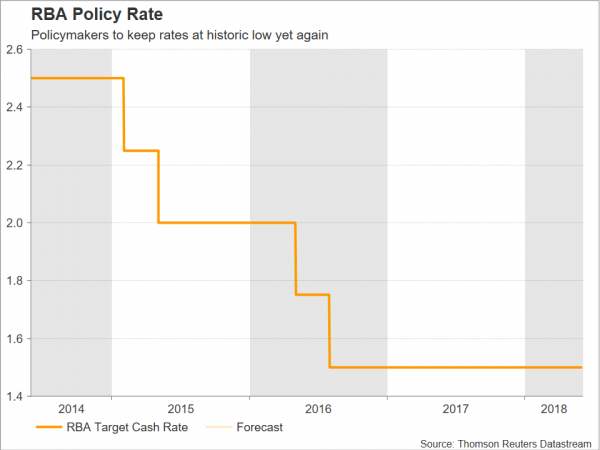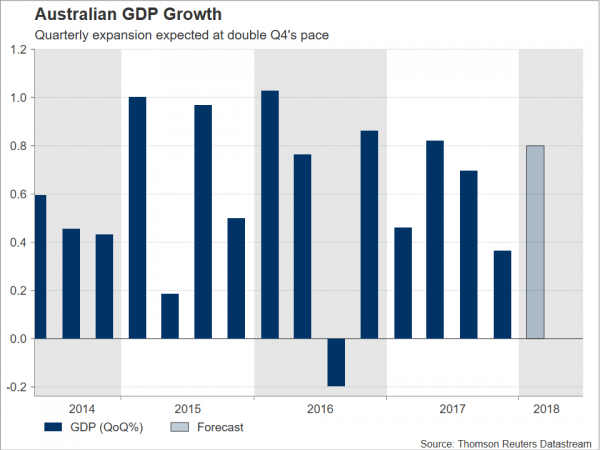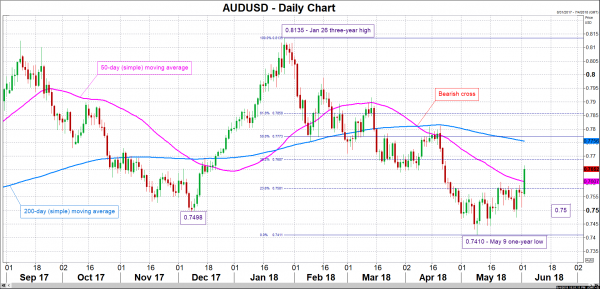The Reserve Bank of Australia will be completing its meeting on monetary policy on Tuesday, with a decision on interest rates scheduled for release at 0430 GMT. No change in rates is anticipated, with positioning on the aussie expected to be dictated by the tone given by the Bank in the statement accompanying the decision. Meanwhile, also of importance out of Australia are Q1 GDP figures due on Wednesday.
Australian headline inflation remained unchanged at 1.9% y/y in Q1, missing analysts’ forecasts that it would touch the lower band of the RBA’s 2-3% inflation target. The last time inflation growth entered the target band was in Q1 2017, when headline CPI came in at 2.1% y/y. In light of the inflation shortfall, the cash rate, this being the central bank’s policy rate, is widely expected to be maintained at the historic low of 1.50% for the 20th consecutive meeting. This constitutes the longest such stretch without an interest-rate move in the nation’s modern history.
But inflation undershooting the RBA’s target is not the only factor deterring the Bank from entering a rate normalization cycle. Worries over global trade are also an issue of consideration for RBA policymakers, and this was expressed during the Bank’s meeting in April as well. Concerns are justified due to the Australian economy’s status as a major commodity exporter and its close economic ties with China. An escalation of tensions between China and the US that introduces barriers to trade could weigh on Australia’s growth trajectory.
With respect to the latest developments on the trade front, US Secretary of Commerce Wilbur Ross was in Beijing over the weekend for talks with Chinese officials. Discussions failed to lead to a constructive outcome though, with the two parties maintaining a confrontational stance. Nevertheless, the market’s reaction was not a shift to risk-off assets, as it seems investors are getting used to such behavior by the world’s two largest economies; in the absence of conclusive measures against one-another, this was merely interpreted as posturing. Any updates on the topic in the days to come will be closely monitored.
Other RBA problem-areas that are keeping rates on hold, are high household debt levels and tepid wage growth despite overall robust jobs numbers that also pertain to full-time positions which are of more significance compared to part-time ones. Salaries not rising in a considerable fashion are also related to the relatively subdued inflation readings as well.
However, not all is gloomy, and the central bank has recently expressed optimism, projecting GDP growth to surpass potential output during 2018, as well as inflationary pressures as gauged by the CPI to increase gradually to a little above 2% on an annual basis.
Overall, a neutral stance is anticipated by the RBA in the statement justifying the rate decision upon completion of its meeting.
As far as GDP is concerned, the numbers pertaining to the first quarter of the year will be released on Wednesday at 0130 GMT, with growth anticipated to have accelerated during the quarter on both a quarterly (0.8% vs 0.4% in Q4) and yearly (2.7% vs 2.4% in Q4) basis. These are also likely to prove market-sensitive, while it is of note that the prints would add to the impressive more-than-two-decade run without a technical recession, defined as two consecutive quarters of economic contraction.
In terms of reaction in the FX markets and focusing on AUDUSD, an upbeat assessment of the Australian economy by the RBA, or a GDP beat, are likely to boost the pair. A barrier to price gains could come around the 38.2% Fibonacci retracement level of the January 26 to May 9 downleg at 0.7687. Notice that the area around this mark was relatively congested between mid-March and early-April, while it also encapsules the 0.77 round figure that may be of psychological importance. Steeper advancing would turn the attention to the region around the 200-day moving average line at 0.7756. Conversely, a cautious tone by the central bank that further pushes back in time market expectations for a rate hike, or disappointing GDP numbers, are expected to exert selling pressure in the aussie/dollar pair. Support to declines could initially emerge around the 50-day MA at 0.7607, including the 0.76 handle. Notice that the 50-day MA failed to act as resistance on the way up earlier on Monday, and may instead act as support. The 23.6% Fibonacci level lies not far below at 0.7581, while more bearish movement would increasingly bring into scope the 0.75 handle, which may also hold psychological significance.
Price action in aussie/dollar saw the pair rise to a six-week high of 0.7659 on Monday, rendering the aussie the strongest performer of the majors as the week got underway. The notable advance – +1.2% at 1251 GMT, the time of writing – partially came on the back of better-than-forecast Australian retail sales data released earlier in the day.
For the record and according to a Reuters poll, analysts do not see the RBA delivering a 25bps rate hike before Q2 2019. This compares to last month’s poll, where the consensus view made reference to a rate increase by March (Q1) next year.
Lastly, at 0130 GMT, a few hours before the RBA meeting concludes, data on Q1’s current account balance and net exports contribution to growth will also be made public out of Australia. These are also of importance and can lead to positioning in the aussie/dollar pair; the numbers can also give an indication regarding Q1 GDP figures due the following day. In the meantime, US releases should also be watched for their influence on the pair; one noteworthy data point on Tuesday’s calendar is the ISM’s non-manufacturing PMI for May.

















